Web Conference Tools
Over the last few years, webinars seem to have taken over as a favorite communication method. Whether using Zoom, Adobe Connect, or even Skype for Business, having good technology will help ensure these sessions run smoothly and you have the best experience possible! Here are a few great webinar tech options.
The first and most important items are microphones and speakers. We recommend combining this into a headset with mic so you can focus on connecting one device instead of two. A great headset option, and one that I use, is the Logitech USB Headset. This headset connects to your computer via your USB port. It is comfortable to wear and set up is easy with plug and play installation. They are also affordable at around $30 a set.
We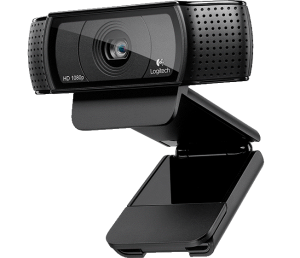 bcams are also useful to have especially in Zoom web meetings. There are many great webcams on the market to choose from. According to Wirecutter.com, a popular website for rating technology tools, the Logitech HD C920 is the best option for your money. It has excellent screen resolution, built in mic, automatic noise reduction, and fast autofocus. This webcam will cost about $100 (sales have been found putting this webcam in the $75 range, so don’t rule it out until you price check this one!)
bcams are also useful to have especially in Zoom web meetings. There are many great webcams on the market to choose from. According to Wirecutter.com, a popular website for rating technology tools, the Logitech HD C920 is the best option for your money. It has excellent screen resolution, built in mic, automatic noise reduction, and fast autofocus. This webcam will cost about $100 (sales have been found putting this webcam in the $75 range, so don’t rule it out until you price check this one!)
If $100 is too high, the Logitech C615 ($70) and C525 ($60) are also great webcam options. While you do sacrifice some quality of picture with these models, they both have the same plug and play ease as the C920. The C615 is also a great portable option as the clip stand folds around the camera and protects the lens during travel.


For offices with conference rooms that may host a web meeting from time to time, the Logitech BCC950 conference camera is a great option.  It has an adjustable webcam (an extender comes with the product), built in speakerphone, and built in microphone. While a little pricey, at $250, the attendees will be able to communicate clearly with the presenters while providing a clear picture of the room where they are.
It has an adjustable webcam (an extender comes with the product), built in speakerphone, and built in microphone. While a little pricey, at $250, the attendees will be able to communicate clearly with the presenters while providing a clear picture of the room where they are.
Windows 10 now has ads in File Explorer, and this is how to remove them.
Recently Microsoft has decided to start embedding ads into File Explorer. Not Internet Explorer, but File Explorer. When you open up a folder like My Documents or My Computer you can now have an ad placed at the top of the window. I have seen this recently myself and the internet is buzzing about it. Unfortunately it is automatically enabled by default, but luckily you can disable it.
- Launch File Explorer
- Click the View Tab and select Options
- Under Folder Options, click the View tab
- In the Advanced Settings window scroll down to the bottom.
- Somewhere close to the bottom you should see “Show sync provider notifications”. You will want to uncheck this box.
- Click Apply then OK.
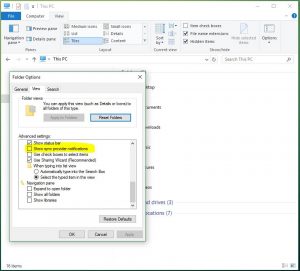
So far this should disable ads from inside File Explorer. This is very new and only been happening for a few days. It seems to run ads for products you may already be using, but they offer a “Pro” version at a cost. Just be careful of these, because there has not been a lot of detail about what the ads may contain. It could possibly make it where you think you may need to update your software when you do not need to.
-Mike Rasmussen
Automatically Connecting to Public Networks
It seems everywhere we go, free wireless networks seem to exist. From our favorite local coffee shop, to the McDonalds down the street and even in the parking lots of a doctor’s office. While these public networks seem great, especially for those of us with limited data plans on our smartphones, we have to remember these networks are not secure and can be easily compromised. Even more worrisome, your phone or computer might be automatically connecting to these networks.
I ran into such a situation the other day. I was a little early for a doctor’s appointment and had my laptop with me so I thought I would catch up on some notes. When I turned on my laptop, I noticed I had connected to a network. This concerned me because there was no reason my laptop would have access to this network. I opened my network settings to try to get to the bottom of why it just “connected” to this unknown network. As I went through trying to decipher what network settings were enabled, I came across “W-Fi Sense”. In the description, above the On/Off radio button, it stated“Connect to suggested open hotspots”. I immediately disabled this setting because I want to be in control of networks my computer connects too.
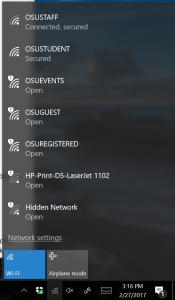
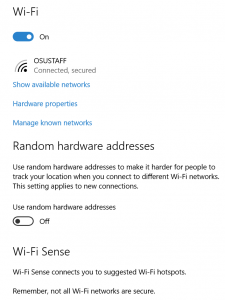
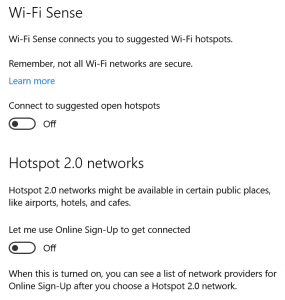
Personal computers are not the only devices that can auto connect to a network. Androids and iPhones/iPads also have the ability to auto connect to hotspots. I recommend disabling these features on those devices as well.
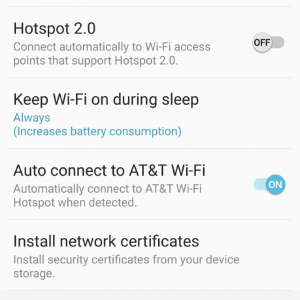

As always, if you have a question or concern, contact your support specialist
~Cynthia Hobbs